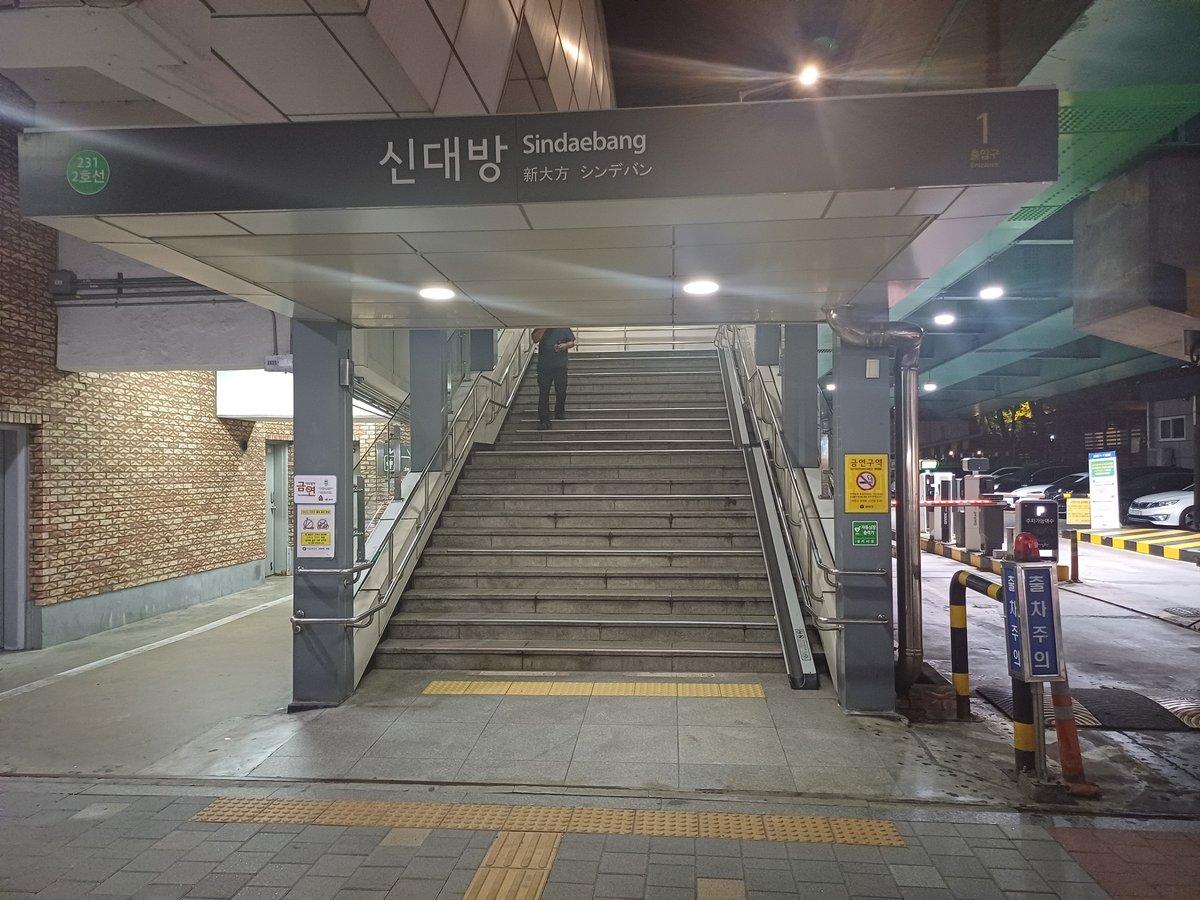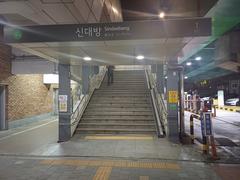
Sindaebang Station Seoul: Visiting Hours, Tickets, and Travel Guide
Date: 15/06/2025
Introduction
Sindaebang Station, situated in southwestern Seoul on Seoul Metro Line 2, is more than just a transit stop—it’s a gateway to some of the city’s most authentic neighborhoods, vibrant community spaces, and seasonal natural beauty. Since its opening in 1984, Sindaebang has played a crucial role in Seoul’s urban evolution, linking residents and visitors to key districts, recreational parks, and historical sites. This guide provides a comprehensive overview of visiting hours, ticketing options, facilities, accessibility, nearby attractions, and insider tips to help you make the most out of your visit to Sindaebang Station.
For further details and visual resources, explore Seoul Sub→urban, Visit Seoul Transportation, and Ploy’s Little Atlas.
Table of Contents
- Overview and Urban Context
- Visiting Hours and Ticket Information
- Station Layout and Design
- Facilities and Accessibility
- Transportation Connections
- Nearby Attractions and Seasonal Highlights
- Local Culture and Community Life
- Visitor Tips and FAQ
- Conclusion
- References
Overview and Urban Context
Sindaebang Station is a pivotal node on Line 2, Seoul’s busiest subway loop. Built during a period of rapid urban expansion, it connects the Dongjak-gu and Sillim-dong districts—areas that have grown from peripheral neighborhoods into thriving residential and commercial centers (Seoul brief insight into its history and urban development). The station’s name, meaning “New Daebang,” reflects its origins and its role in linking the past and present of this dynamic city.
Visiting Hours and Ticket Information
- Operating Hours: Sindaebang Station is open daily from approximately 5:30 AM to midnight, consistent with Seoul Metro Line 2’s standard schedule.
- Ticketing:
- Single-Journey Tickets: Purchase at vending machines in the station. Fares depend on distance, with an additional KRW 500 refundable deposit (Visit Seoul Transportation).
- T-money Card: A rechargeable transportation card for subway, bus, and taxi rides, available at station kiosks and convenience stores.
- Tourist Passes: One-day and multi-day passes allow unlimited subway rides, ideal for travelers planning extensive city exploration.
Station Layout and Design
Sindaebang Station is an elevated structure above the Dorim Stream, supported by concrete pillars that integrate seamlessly with the urban landscape (Seoul Sub→urban). Natural light and airflow enhance the platform environment, and the station’s above-ground design offers scenic views of the surrounding area.
Exits and Access
- Exits 1–4: All exits converge on a cross-street above the stream, providing direct access to local amenities, the Dorim Stream walkway, and nearby neighborhoods.
- Exit 4: Recommended for Boramae Park visitors; a short walk along the stream leads directly to the park (Trippose Boramae Park).
Facilities and Accessibility
- Accessibility: The station is equipped with elevators, escalators, tactile paving, and barrier-free restrooms. Multilingual signage (Korean, English, Chinese) assists all travelers.
- Restrooms: Clean and well-maintained, located within the station.
- Retail and Food: Sidewalk vendors and tent restaurants near Exits 2 and 3 offer local snacks and meals; convenience stores provide T-money card services.
- Parking: Limited parking is available beneath the station for short-term use.
- Safety: CCTV and station staff ensure high safety standards throughout operating hours.
Transportation Connections
Subway
- Line 2: Trains arrive every 2–5 minutes during peak hours, providing efficient access to Seoul’s major districts (Seoul Metro Line 2 map).
Buses
- Blue Buses: Main city routes.
- Green Buses: Connect to residential districts.
- Red Buses: Intercity connections.
- Key Bus Lines: Green 5011, 5516, Blue 152, and others serve Boramae Park, Lotte Department Store, and neighboring areas (Visit Seoul Transportation).
Walking, Cycling, and Taxis
- Walking/Cycling: The Dorim Stream walkway and Seoul’s Ttareungyi bike-sharing stations are easily accessible (The Seoul Guide).
- Taxis: Readily available near all exits, with payment options including T-money and credit cards.
Airport and Intercity Access
- Airport Transfers: Transfers to AREX (Incheon/Gimpo airports) via Line 2 at Hongik University or Seoul Station.
- KTX (High-Speed Rail): Reachable via Seoul or Yongsan Stations with subway transfers (Korea Travel Planning).
Nearby Attractions and Seasonal Highlights
Boramae Park
A major urban park located near Exit 4, featuring walking trails, playgrounds, and cultural facilities (Trippose Boramae Park).
Dorimcheon Promenade & Cherry Blossoms
The Dorimcheon stream transforms each spring with rows of blooming cherry trees, accessible from Exits 2 and 3. The promenade offers tranquil walks and excellent photo opportunities (Ploy’s Little Atlas).
Nangok Road
A favored cherry blossom spot directly across from Exits 1 and 2, known for its evening illuminations.
Noryangjin Fish Market & Seoul National Cemetery
Both are easily reached by subway or bus for those interested in local culture and history.
Other Seasonal Highlights
- Spring: Cherry blossom viewing along Dorimcheon and Nangok Road.
- Summer: Easy subway access to major festivals citywide.
- Autumn: Foliage in nearby parks and along the stream.
- Winter: Local street food vendors offer warming snacks and comfort foods.
Local Culture and Community Life
Sindaebang and its surrounding neighborhoods offer a window into everyday Seoul. Local markets, affordable eateries, and bustling community spaces reflect a blend of tradition and modernity. While English is less common in this area, translation apps and basic Korean phrases can enhance interactions. The area is especially popular with students and young professionals, contributing to its lively street scenes.
Visitor Tips and FAQ
Tips
- Best Time for Cherry Blossoms: Late March to mid-April.
- Navigation: Use T-money cards for convenience; maps and apps like Audiala provide real-time transit updates.
- Local Etiquette: Be courteous in markets, refrain from eating on trains, and respect priority seating.
- Accessibility: Elevators, ramps, and barrier-free facilities are available throughout the station.
Frequently Asked Questions
Q: What are Sindaebang Station’s operating hours?
A: Approximately 5:30 AM to midnight daily.
Q: How do I buy subway tickets?
A: Use single-journey ticket machines or purchase/recharge a T-money card at station kiosks and convenience stores.
Q: Is the station accessible for disabled visitors?
A: Yes, with elevators, tactile paving, multilingual signage, and accessible restrooms.
Q: Are there places to eat nearby?
A: Yes, with numerous local markets, street vendors, and tent restaurants near the station.
Q: Are there fees to visit nearby attractions?
A: Most local attractions like the Dorimcheon promenade and Nangok Road are public spaces and free to enter.
Conclusion
Sindaebang Station stands as a dynamic portal to Seoul’s rich community life, urban history, and seasonal beauty. Its strategic location on Line 2 ensures excellent connectivity, while comprehensive facilities and accessibility features guarantee a smooth travel experience for all visitors. Whether you’re seeking cherry blossoms, authentic local cuisine, or simply an efficient way to explore Seoul’s southwestern districts, Sindaebang Station is an ideal starting point.
For real-time updates and navigation, download the Audiala app. To learn more about Seoul’s transit system and attractions, consult the official Seoul Metro website and explore additional guides listed below.
References
- Seoul Sub→urban
- Visit Seoul Transportation
- Ploy’s Little Atlas
- Trippose Boramae Park
- The Seoul Guide
- Korea Travel Planning
- Seoul Metro Official Website
- Seoul brief insight into its history and urban development
- Seoul Solution: Urban Planning System
- Seoul Solution: Bottom-up Plan
- Seoul Urban Planning
- Seoul History Facts and Timeline
- Visit Seoul Accessibility Guide
- Wikipedia’s page on Sindaebang Station
For enhanced planning, include interactive maps with station exits and nearby attractions, and use descriptive image alt text such as “Cherry blossom trees in full bloom along Dorimcheon Promenade near Sindaebang Station.”













































































































































































































